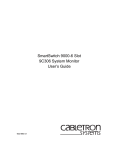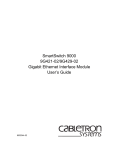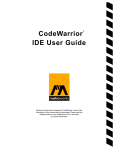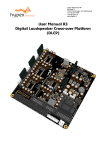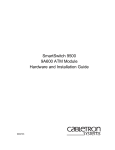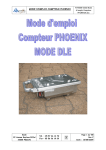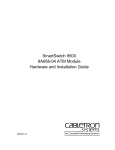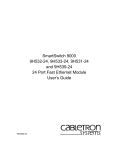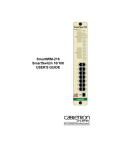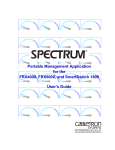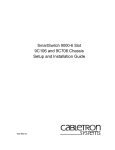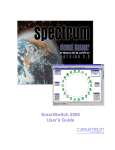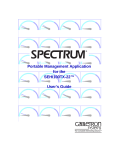Download Cabletron Systems GIGAswitch GSR-16 User`s guide
Transcript
SmartTrunk User’s Guide 9032680 Notice Notice Cabletron Systems reserves the right to make changes in speciÞcations and other information contained in this document without prior notice. The reader should in all cases consult Cabletron Systems to determine whether any such changes have been made. The hardware, Þrmware, or software described in this manual is subject to change without notice. IN NO EVENT SHALL CABLETRON SYSTEMS BE LIABLE FOR ANY INCIDENTAL, INDIRECT, SPECIAL, OR CONSEQUENTIAL DAMAGES WHATSOEVER (INCLUDING BUT NOT LIMITED TO LOST PROFITS) ARISING OUT OF OR RELATED TO THIS MANUAL OR THE INFORMATION CONTAINED IN IT, EVEN IF CABLETRON SYSTEMS HAS BEEN ADVISED OF, KNOWN, OR SHOULD HAVE KNOWN, THE POSSIBILITY OF SUCH DAMAGES. © Copyright October 1998 by: Cabletron Systems, Inc. P.O. Box 5005 Rochester, NH 03867-5005 All Rights Reserved Printed in the United States of America Order Number: 9032680 Cabletron Systems and FNB are registered trademarks and SmartSwitch, SmartTrunk, and SmartMIM-216 are trademarks of Cabletron Systems, Inc. All other product names mentioned in this manual may be trademarks or registered trademarks of their respective companies. i Notice FCC Notice This device complies with Part 15 of the FCC rules. Operation is subject to the following two conditions: (1) this device may not cause harmful interference, and (2) this device must accept any interference received, including interference that may cause undesired operation. NOTE: This equipment has been tested and found to comply with the limits for a Class A digital device, pursuant to Part 15 of the FCC rules. These limits are designed to provide reasonable protection against harmful interference when the equipment is operated in a commercial environment. This equipment uses, generates, and can radiate radio frequency energy and if not installed in accordance with the operatorÕs manual, may cause harmful interference to radio communications. Operation of this equipment in a residential area is likely to cause interference in which case the user will be required to correct the interference at his own expense. WARNING: Changes or modiÞcations made to this device which are not expressly approved by the party responsible for compliance could void the userÕs authority to operate the equipment. VCCI Notice This is a Class A product based on the standard of the Voluntary Control Council for Interference by Information Technology Equipment (VCCI). If this equipment is used in a domestic environment, radio disturbance may arise. When such trouble occurs, the user may be required to take corrective actions. Industry Canada Notice This digital apparatus does not exceed the Class A limits for radio noise emissions from digital apparatus set out in the Radio Interference Regulations of the Canadian Department of Communications. Le prŽsent appareil numŽrique n'Žmet pas de bruits radioŽlectriques dŽpassant les limites applicables aux appareils numŽriques de la class A prescrites dans le R•glement sur le brouillage radioŽlectrique ŽdictŽ par le minist•re des Communications du Canada. ii Notice Declaration of Conformity Addendum Application of Council Directive(s): 89/336/EEC 73/23/EEC ManufacturerÕs Name: Cabletron Systems, Inc. ManufacturerÕs Address: 35 Industrial Way European Representative Name: European Representative Address: Conformance to Directive(s)/Product Standards: Equipment Type/Environment: PO Box 5005 Rochester, NH 03867 Mr. J. Solari Cabletron Systems Limited Nexus House, Newbury Business Park London Road, Newbury Berkshire RG13 2PZ, England EC Directive 89/336/EEC EC Directive 73/23/EEC EN 55022 EN 50082-1 EN 60950 Networking Equipment, for use in a Commercial or Light Industrial Environment. We the undersigned, hereby declare, under our sole responsibility, that the equipment packaged with this notice conforms to the above directives. Mr. Ronald Fotino ____________________________________________________ Full Name Mr. J. Solari ______________________________________________________ Principal Compliance Engineer ____________________________________________________ Managing Director - E.M.E.A. ______________________________________________________ Title Title Rochester, NH, USA ____________________________________________________ Location Newbury, Berkshire, England ______________________________________________________ Full Name Location iii Notice iv Contents Chapter 1 Introduction SmartTrunking............................................................................................................... 1-1 Packet Distribution ....................................................................................................... 1-2 Compatibility - DEC Hunt Groups and GigaSwitch Router (GSR) ..................................................................................... 1-3 Chassis with Multiple SmartTrunk Groups .............................................................. 1-3 SmartTrunk and Port Connections ............................................................................. 1-4 Correspondence ............................................................................................................ 1-7 Chapter 2 SmartTrunk Configuration SmartTrunk ConÞguration Rules................................................................................ 2-1 SmartTrunking ConÞguration Screen ........................................................................ 2-3 Exiting the SmartTrunking ConÞguration Screen............................................. 2-5 Appendix A Helpful Hints for Configuring SmartTrunk Creating a Second Trunk Group ................................................................................ A-2 Removing an Entire Trunk Group ............................................................................. A-3 Removing a Port from a Group.................................................................................. A-3 v Contents vi Chapter 1 Introduction Traditional 802.1D Spanning Tree Bridges only allow one active data path between any two switches; all other parallel data paths are in Standby or Blocking mode. If one interface or path should fail, then the other interface automatically comes out of Blocking mode and forwards all of the trafÞc. This is Þne for redundancy purposes. However, it is not the most efÞcient use of resources. SmartTrunk, also referred to as SmartTrunking, is Cabletron SystemsÕ terminology for load balancing or load sharing. SmartTrunk provides the ability to take full advantage of the networkÕs redundant bandwidth. SmartTrunk divides network trafÞc across multiple ports in parallel to provide additional throughput. The SmartTrunk application can be used with any of DigitalÕs MultiSwitch 700 switch modules (except ATM modules). SmartTrunking A physical port conÞgured in a SmartTrunk Group must: ¥ ¥ ¥ Be connected in a point-to-point link (full-duplex is recommended) Be connected to a port that is also conÞgured as part of a SmartTrunk Group Have Spanning Tree protocol enabled Whenever a physical port is conÞgured in a SmartTrunk Group, the port will send proprietary protocol messages (see PLAP and LLAP information in the Compatibility section). Once the two switches at opposite ends of the link agree that the trunking state is enabled, the SmartTrunk Group is established. As additional ports are identiÞed as belonging to the same SmartTrunk Group, the SmartTrunk Group is automatically reconÞgured to take advantage of the additional paths. 1-1 Introduction Packet Distribution Packet distribution is based on hardware family type: MultiSwitch 700 Packet distribution among the ports in the group is accomplished by adding the destination and source MAC addresses and then applying the modulus operator to the sum using the number of active ports in the group. The remainder, which falls into the range of the number of ports in the group, will dictate which port will be used by the address. This gives a random distribution of the packet load, but insures that the same destination-source ßow always goes out the same port. This alleviates the possibility of out-of-order packets. Modulus Examples Ports contained in the trunk are labeled from zero (0) to one less than the number of ports in the group. For example, if the physical ports in the group are 1 3 5 7 9, packet distribution would be based on the trunking port number assigned. Trunking port numbers are 0 1 2 3 4. The modulus operator divides the Þrst number by the second number and yields a whole number remainder: (sum of addresses) modulus (number of trunk ports) = remainder For example: 5 mod 4 = 1 (Four goes into Þve once with a remainder of one) 4 mod 5 = 4 (Five goes into four no times with a remainder of four) The remainder is the useful number that will fall between zero (0) and one less than the number of trunk ports. This remainder will dictate which trunk port is used to send the trafÞc by matching it to the trunking port number. 1-2 Introduction Compatibility - DEC Hunt Groups and GigaSwitch Router (GSR) SmartTrunking for the MultiSwitch 700 is based on, and compatible with, DEC Hunt Groups. Adopting the DEC Hunt Groups protocol allows the MultiSwitch 700 to be trunked together with the GigaSwitch Router (GSR) and other DEC equipment supporting this feature. (See the Þrmware release notes for the compatibility of the individual image selected). SmartTrunking and Hunt Groups are comprised of two protocols: ¥ Logical Link Aging Protocol (LLAP) - Assists in learning and aging. ¥ Physical Link AfÞnity Protocol (PLAP) - Monitors and maintains the trunking states. Chassis with Multiple SmartTrunk Groups A SmartTrunk ÒgroupÓ consists of two or more ports, and deÞnes a single logical connection to a MultiSwitch 700 module. By creating identical groups on modules in two different MultiSwitch 700 chassis, a point-to-point SmartTrunk can be established between the switches to increase the available bandwidth and provide link redundancy. Figure 1-1 depicts a single example of a network with several MultiSwitch 700 chassis using SmartTrunking. In this example, a module in one MultiSwitch 700 (chassis #1) supports two different SmartTrunk groups to other MultiSwitch 700 chassis (#2 and #3). Group ÒAÓ forms the SmartTrunk that connects a module in chassis #1 to a module in chassis #3. Group ÒBÓ forms a separate SmartTrunk that connects the same module in chassis #1 to a module in chassis #2. Thus, the module in chassis #1 is shown as having Òmultiple groupsÓ when viewed through management screens (through a Local Management console or remote management software). SmartTrunk can be conÞgured in a number of different ways on MultiSwitch 700 modules. A MultiSwitch 700 module can be conÞgured to support a single SmartTrunk groups consisting of virtually any number of ports (essentially limited to the number of ports on the module). Or, a module can be conÞgured to support multiple SmartTrunk groups, creating trunk connections to several other switches (see Figure 1-1). The particular conÞguration chosen for each MultiSwitch 700 module depends on the overall network design. 1-3 Introduction Users MultiSwitch 700 Chassis #2 MultiSwitch 700 Users MultiSwitch 700 9C106 SmartMIM-216 9C106 SmartMIM-216 Group B Group B on Chassis #2 MultiSwitch 700 Chassis #1 Both Groups on Chassis #1 Group A MultiSwitch 700 Chassis #3 MultiSwitch 700 9C106 SmartMIM-216 Group A on Chassis #3 Users Figure 1-1. Chassis with Multiple SmartTrunk Groups Enabled SmartTrunk and Port Connections The SmartTrunk application dynamically determines network loops and is used concurrently with the Spanning Tree protocol. The SmartTrunk application only acknowledges its neighboring switches. If a user goes through several switch hops, then loops back to the Þrst switch hop (creating a loop), a common connection between two switches (any two) will go into a blocking state (see Figure 1-2). 1-4 Introduction MultiSwitch 700 Chassis MultiSwitch 700 SmartMIM-216 MultiSwitch 700 Chassis MultiSwitch 700 9C106 SmartMIM-216 SmartMIM-216 9C106 SmartMIM-216 SmartTrunk connections blocked MultiSwitch 700 Chassis MultiSwitch 700 SmartMIM-216 9C106 SmartMIM-216 Figure 1-2. SmartTrunk with a Network Loop Port costs are considered by SmartTrunk when disabling a looped conÞguration. SmartTrunk will place the higher path costs of the group interfaces into a blocked state. Path cost will be calculated using the following equations: Speed The speed of the interface (typically in megabits). For example, 10, 100, or 1000 (see Table 1-1). Table 1-1. Example Port Speeds Port Type Speed 10 Mb, Half Duplex 100 10 Mb, Full Duplex 50 100 Mb, Half Duplex 10 100 Mb, Full Duplex 5 1-5 Introduction Active Trunk Links The number of links participating in the trunking group. If all the ports in the trunking group are the same speed and conÞgured to the same duplex mode, the equation is: 1000 -----Speed x # of ports If the ports in the trunking group are different speeds, the equation is: 1000 -----Speed 1 + Speed 2 + Speed 3 + Speed n... Trunking (Active) MultiSwitch 700 Chassis MultiSwitch 700 SmartMIM-216 MultiSwitch 700 Chassis MultiSwitch 700 9C106 SmartMIM-216 SmartMIM-216 9C106 SmartMIM-216 1 2 Blocked The active path is determined by the lowest combined path cost. The higher path cost ports will be blocked. Figure 1-3. A Redundant Standby Path for Trunking Multiple trunks can also be established between chassis-based switches, but only one group of trunk ports will be active. The trunked ports do not necessarily need to be on the same module. A Blocked state for all ports in the Group in Standby will be reßected on the SmartTrunking Local Management screen. 1-6 Introduction NOTES When this conÞguration is used, only one moduleÕs SmartTrunk Group will be active. The second path will block and serve as a backup to the currently active path. (The active trunking path will be determined by the module providing the lowest path cost.) Refer to the release notes for image-speciÞc restrictions while using SmartTrunking. NOTE The only time path cost is calculated is when a port is added or removed from the trunking group. While the trunking group is operational, losses of link or PLAP on a port will not result in path cost recalculation. In order for a redundant group to become active, the entire primary group must become inactive or disabled. Correspondence Documentation Comments If you have comments or suggestions about this manual, send them to DIGITAL Network Products: Attn.: Documentation Project Manager E-MAIL: [email protected] World Wide Web To locate product-speciÞc information, refer to the DIGITAL Network products home page on the World Wide Web at the following locations: North America: http://www.networks.digital.com Europe: http://www.networks.europe.digital.com Asia PaciÞc: http://www.networks.digital.com.au 1-7 Introduction Getting Help Contact your Digital representative for technical support. Before calling, having the following information ready: 1-8 ¥ A description of the failure ¥ A description of any action(s) already taken to resolve the problem (e.g., changing mode switches, rebooting the unit, etc.) ¥ A description of your network environment (layout, cable type, etc.) ¥ Network load and frame size at the time of the trouble (if known) ¥ The device history (i.e., have you returned the device before, is this a recurring problem, etc.) Chapter 2 SmartTrunk Configuration Prior to entering information in the SmartTrunking ConÞguration Screen, you should understand the concept of SmartTrunk (see Chapter 1) and the SmartTrunk ConÞguration Rules. SmartTrunk Configuration Rules The following rules apply when conÞguring ports for SmartTrunking. NOTE Failure to follow these rules will produce poor network performance. 1. SmartTrunking ports should be conÞgured to Full Duplex. 2. You cannot loop front panel ports back to the same module, to the same chassis, or to different modules within that chassis. Loops are intended to connect one chassis to another chassis. 3. You must enable Spanning Tree before you enable SmartTrunk. If a network loop exists and SmartTrunk becomes disabled, then as long as Spanning Tree is enabled, the Spanning Tree algorithm will respond and block the necessary ports. 4. If a network loop exists and SmartTrunk becomes disabled, and Spanning Tree is also disabled, then an inÞnite packet loop will occur and cripple the network. 5. If a SmartTrunking port becomes unusable, all other trafÞc is redirected over the remaining port(s) in the group. 6. Backplane ports (FTM) on chassis-based switches cannot be conÞgured as SmartTrunk ports and are not eligible to participate in trunking. 2-1 SmartTrunk Configuration 7. An end station plugged directly into a port conÞgured for SmartTrunking will not be allowed to communicate. No trafÞc will ßow into the port. 8. The same SmartTrunk group cannot be split onto two separate modules (see Figures 2-1 and 2-2). MultiSwitch 700 9C106 SmartMIM-216 Group A MultiSwitch 700 MultiSwitch 700 9C106 SmartMIM-216 9C106 SmartMIM-216 Figure 2-1. ILLEGAL CONFIGURATION (Example 1) MultiSwitch 700 9C106 MultiSwitch 700 9C106 SmartMIM-216 Group A SmartMIM-216 Figure 2-2. ILLEGAL CONFIGURATION (Example 2) 2-2 SmartTrunk Configuration SmartTrunking Configuration Screen To select the SmartTrunking ConÞguration Screen from the Module ConÞguration Menu: 1. Use the arrow keys to highlight the SmartTrunking ConÞguration option. 2. Press the ENTER key. The SmartTrunking ConÞguration Screen, Figure 2-3, appears. DLE22-MA LOCAL MANAGEMENT SmartTrunking Configuration Device Type: DLE22-MA Firmware Revision: XX.XX.XX BOOTPROM Revision: XX.XX.XX SmartTrunk Group: SmartTrunk Logical Port: Port State ---------------- Port State ----------------- SmartTrunk State: [ENABLED] Add/Remove Group: Display Group: SAVE UPDATE Port State ----------------- Group: [ ADD ] Port: [REMOVE] EXIT RETURN Figure 2-3. SmartTrunking Configuration Screen The following section brießy explains each Þeld on the SmartTrunking ConÞguration Screen. SmartTrunk Group The title of the group that is active in the screen. SmartTrunk Logical Port IdentiÞes the bridge port number used by all members of the SmartTrunking group. 2-3 SmartTrunk Configuration SmartTrunk State (Toggle) Used to enable or disable SmartTrunking for all groups deÞned on the device. ¥ ¥ ¥ ¥ ENABLE - Select to change state to On ENABLED - Currently On DISABLE - Select to change state to Off DISABLED - Currently Off Add/Remove Group A user-deÞned 32-character string describing the group of SmartTrunk ports. Group Is either of the following: ¥ ADD - Create a SmartTrunk Group Name. The name Þeld will become empty, awaiting user input. ¥ DELETE - Remove the SmartTrunk Group Name. The name Þeld will automatically Þll with SmartTrunk names found on the device. Users may either type in the name to be deleted or use the SmartTrunk Group Þeld to toggle through the list of names found on the switch. Display Group A list of the SmartTrunk groups available on this device. Selecting a group updates the table in the center of the screen. The table displays the ports and current state of the members included in the group. If no groups have been created (Added), then this Þeld will remain blank and the table will display no data. Port When State is: NOTE ¥ ADD - Displays the ports available to add to the displayed group. Ports assigned to other trunk groups will not show up in this list because they are not available to add. ¥ REMOVE - Displays a list of ports currently assigned to the active SmartTrunk group. They are the only ports available for deletion. A SmartTrunk port in a disabled state will not allow any trafÞc to ßow until the appropriate corresponding trunk group is connected. Inadvertently conÞguring a user-attached port to a member of a SmartTrunking group will result in the user losing network connectivity. UPDATE (Command) Refreshes the table currently displayed. 2-4 SmartTrunk Configuration After making modiÞcations, you must select the SAVE command to save your changes. The NEXT and PREVIOUS commands will be displayed when there are more than 18 ports. ¥ To access ports on the device not seen on the primary screen, use the arrow keys to highlight the NEXT command at the bottom of the screen, then press the Return key. ¥ To view the previous screen of ports, use the arrow keys to highlight the PREVIOUS command at the bottom of the screen, then press the Return key. Exiting the SmartTrunking Configuration Screen To exit the SmartTrunking ConÞguration Screen, use the arrow keys to highlight RETURN and press the Return key. 2-5 SmartTrunk Configuration 2-6 Appendix A Helpful Hints for Configuring SmartTrunk NOTE This procedure must be completed on both switches participating in Trunking. 1. Navigate through Local Management to the SmartTrunking ConÞguration Screen. 2. Using the arrow keys, move the cursor to the Add/Remove Group Þeld. 3. Type the name of the SmartTrunk group you wish to create. 4. Highlight the SAVE command, and then press the Return key. NOTE The group must be created and saved prior to adding ports to the group. 5. Using the arrow keys, move the cursor to the Port Þeld. 6. Select the port that is to become part of the SmartTrunk Group just created. Press the Spacebar to change the port number. 7. Using the arrow keys, highlight the ADD Þeld, and then press the Return key. The port and state will be added to the table on the trunking page. The port will no longer show in the list of ports that can be added. 8. Repeat steps 5 through 7 to select the next port to be added. If the ports to be added to the group are sequential, start by selecting the lowest port value and continue to press the Return key while on the ADD Þeld. The ports will increment automatically as you press Return. A-1 Helpful Hints for Configuring SmartTrunk 9. After all ports have been added, highlight the SmartTrunk State Þeld. Press the Spacebar to select ENABLED. NOTE In order to minimize the interruption to network trafÞc while trunking is being conÞgured, it is recommended that a port between the switches remains outside the group until the trunking links are active. As soon as you enable a trunking group on one end of the trunk, all trafÞc will stop until the other end of the trunk is enabled. Leaving one port out of the group will allow trafÞc to ßow between switches while trunking is conÞgured and initialized. After the trunk group is running, the single port will block and the trunking path will become the active data path. At this point, the single port may be added to the trunking group. If this is not possible, it is recommended that the trunking groups be created, and ports added on both ends of the trunk before trunking is enabled. Reducing the time between enabling both ends of the group will reduce network interruptions. 10. Highlight the SAVE command, and then press the Return key. 11. Repeat this procedure on the device that is connected to the trunk ports just conÞgured. 12. Once both ends of the Trunk are conÞgured, port states for the group will change from Disabled to Enabled. Creating a Second Trunk Group To create a second trunk Group: 1. Highlight the Add/Remove Group Þeld. Make sure the [ADD/DELETE] Þeld to the right on the same line is conÞgured to [ADD]. 2. Type the name of the SmartTrunk group you wish to create. Highlight the SAVE Þeld, and then press the Return key. NOTE The group must be created and saved prior to adding ports to the group. 3. Continue to add ports to the group as described in the preceding section. A-2 Removing an Entire Trunk Group Removing an Entire Trunk Group To remove an entire trunk Group: 1. Using the arrow keys, highlight the Group: [ADD/DELETE] Þeld (on the same line as the Add/Remove Group Þeld). Press the Spacebar to select [DELETE]. 2. If the name of the group to be deleted doesnÕt appear on the Add/Remove Group Þeld, type the name of the SmartTrunk group you wish to delete. It is also possible to use the Display Group Þeld to toggle through existing groups. This will automatically update Add/Remove Group Þeld. Once the proper name appears in the Add/Remove Group Þeld, highlight the SAVE command, and then press the Return key. The group will be removed. NOTE All ports in the group will be released. It is not necessary to remove ports from a group before deleting the group. Removing a Port from a Group To remove a port form a Group: 1. Select the group to have a port removed. If the name of the group to be deleted doesnÕt appear on the Add/Remove Group Þeld, type the name of the SmartTrunk group you wish reconÞgure. It is also possible to use the Display Group Þeld to toggle through existing groups. This will automatically update the Add/Remove Group Þeld. Once the proper name appears in the Add/Remove Group Þeld, proceed to step 2. 2. Highlight the [ADD/DELETE] Þeld (to the right of the Port Þeld). Press the Spacebar to select [DELETE]. 3. Move the cursor to the Port Þeld. Select the port that is to be removed from the SmartTrunk Group. Press the Spacebar to change the port number. Only ports that are currently members of the group will be displayed. 4. Once the port is selected, highlight the [DELETE] Þeld. 5. To delete the port, press the Return key. 6. Continue to press the Return key and all ports will be deleted. 7. Highlight the SAVE command, and then press the Return key. A-3 Helpful Hints for Configuring SmartTrunk A-4


























